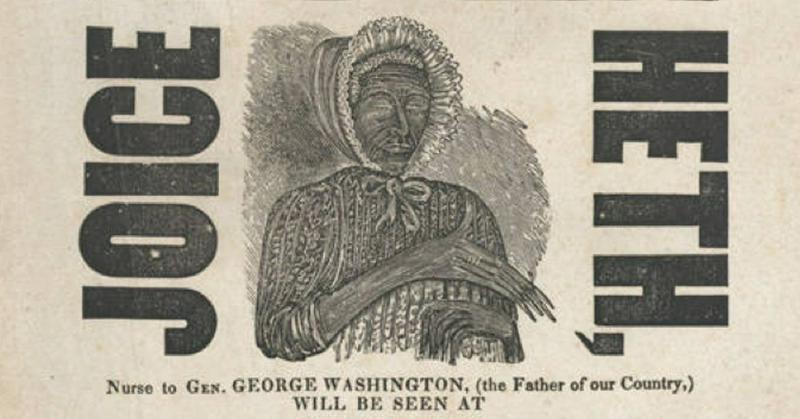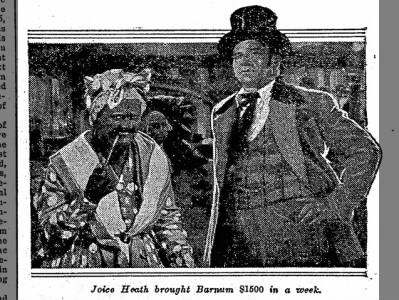Exploitation
There are several accounts of exploitation that Barnum has done that contributed to his success. For the purpose of this research I will only explore his exploitation regarding Joice Heth and Zip the Pinhead.
Definition
Exploit (v.) - to make use of meanly or unfairly for one's own advantage.
Definition based on Merriam Webster.
Oftentimes unethical practices are involved when exploitation is mentioned. In this case, based on my research, Barnum's unethical use of Joice Heth and Zip the Pinhead made his career a success.
Joice Heth
Background
Before Barnum
Based on The Lost Museum Archive, where information is derived from Barnum's autobiography, Heth was a slave at some point. She was sold to different individuals such as Augustine Washington, Elizabeth Atwood and John S. Bowling (Barnum on Joice Heth, 1869).
Prior to Barnum's possession, John S. Bowling had possession of Heth in 1835 and he marketed Heth as an elderly woman who allegedly knew George Washington (Cervone, n.d.). Afterwards, in the same year, R.W. Lindsay of Kentucky purchased her from Bowling. Heth was not a success in their possession, until Barnum purchased her.
Take note that Heth's life before being purchased by various individuals remains largely undocumented, with unreliable evidence available for discussion.
Life with Barnum
Barnum purchased Heth from R.W Lindsay of Kentucky. Barnum exhibited and marketed Heth as an 161-year-old African American woman who was a former wetnurse of George Washington. In reality, Heth was just about 80 years old. Due to Barnum's personality and marketing skills, Heth became a success because she peaked the curiosities of the public.
Barnum marketed Heth as an elderly woman whose continued existence seemed improbable, with her appearance defying expectations of vitality:
... her marvelously decrepit body. Joice Heth was advertised as weighing only forty-six pounds; she was blind and toothless and had deeply wrinkled skin; she was paralyzed in one arm and both legs; and her nails were said to curl out like talons. Visitors regularly shook hands with her, scrutinized her, and sometimes even took her pulse. "Indeed," wrote one observer, "she is a mere skeleton covered with skin, and her whole appearance very much resembles a mummy of the days of the Pharaohs, taken entire from the catacombs of Egypt." (Reiss, 80).
How Did Barnum Exploit Heth?
Profitting Off of False Claims
Ever since Barnum gained possession of Heth, he exhibited her endlessly on tour until she died. During her exhibitions he continued to showcase and profit off of her as George Washington's former wetnurse who was 161-years-old. Barnum claimed that Heth knew George Washington since "She was quite garrulous about her protege "dear little George," at whose birth she declared she was present...As nurse she put the first clothes on the infant and she claimed to have 'raised him.'" (P.T. Barnum on Joice Heth, 1869).
There is no solid evidence of any of these claims regarding Heth to be true. Thorugh these false claims about Heth, he profitted off of her by attracting public attention and an audience to his exhibitions.
Although there are no documents of Heth's personal feelings during her time with Barnum, performing with the same routine continuously at an old age can be physically and emotionally draining.
Profitting Off of Her Death
When Heth died, Barnum profitted off of her autopsy by opening the doors to the public. Admissions were $0.50 and 1,500 spectators showed up (Reiss, 94).
In her autopsy lead by Dr. David L. Rogers, he was able to prove that the entire exhibit Barnum built around Heth was a hoax and she could not have been no more than 80 years old (Reiss, 94). Barnum violated and disregarded her privacy in death, all while exploiting her for his own benefit. In Barnum's autobiography he writes the following about Heth: "I shed tears upon her humble grave – not of sorrow for her decease, but of regret on account of having lost a valuable and profitable curiosity" (Reiss, 100). In the end, Barnum had zero remorse or respect for Heth and simply treated her as money.
Considering these points, it becomes evident that the exploitation of Joice Heth played a significant role in Barnum's success, effectively establishing his reputation as a showman.


